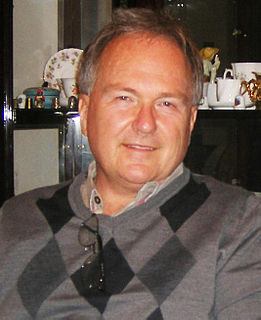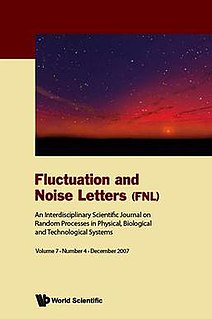Related Research Articles
Pink noise or 1⁄f noise is a signal or process with a frequency spectrum such that the power spectral density is inversely proportional to the frequency of the signal. In pink noise, each octave interval carries an equal amount of noise energy.
Surface science is the study of physical and chemical phenomena that occur at the interface of two phases, including solid–liquid interfaces, solid–gas interfaces, solid–vacuum interfaces, and liquid–gas interfaces. It includes the fields of surface chemistry and surface physics. Some related practical applications are classed as surface engineering. The science encompasses concepts such as heterogeneous catalysis, semiconductor device fabrication, fuel cells, self-assembled monolayers, and adhesives. Surface science is closely related to interface and colloid science. Interfacial chemistry and physics are common subjects for both. The methods are different. In addition, interface and colloid science studies macroscopic phenomena that occur in heterogeneous systems due to peculiarities of interfaces.

A sensor is a device that produces an output signal for the purpose of sensing a physical phenomenon.
Stochastic resonance (SR) is a phenomenon in which a signal that is normally too weak to be detected by a sensor, can be boosted by adding white noise to the signal, which contains a wide spectrum of frequencies. The frequencies in the white noise corresponding to the original signal's frequencies will resonate with each other, amplifying the original signal while not amplifying the rest of the white noise – thereby increasing the signal-to-noise ratio, which makes the original signal more prominent. Further, the added white noise can be enough to be detectable by the sensor, which can then filter it out to effectively detect the original, previously undetectable signal.

Surface plasmon resonance (SPR) is the resonant oscillation of conduction electrons at the interface between negative and positive permittivity material in a particle stimulated by incident light. SPR is the basis of many standard tools for measuring adsorption of material onto planar metal surfaces or onto the surface of metal nanoparticles. It is the fundamental principle behind many color-based biosensor applications and lab-on-a-chip sensors. It should be stressed that SPP is not a resonance on the planar surface and it is a polariton or surface-wave like phenomenon.

Extreme ultraviolet lithography is an optical lithography technology used in steppers, machines that make integrated circuits (ICs) for computers and other electronic devices. It uses a range of extreme ultraviolet (EUV) wavelengths, roughly spanning a 2% FWHM bandwidth about 13.5 nm, to produce a pattern by exposing reflective photomask to UV light which gets reflected onto a substrate covered by photoresist. It is widely applied in semiconductor device fabrication process.

An electronic nose is an electronic sensing device intended to detect odors or flavors. The expression "electronic sensing" refers to the capability of reproducing human senses using sensor arrays and pattern recognition systems.
Quantum imaging is a new sub-field of quantum optics that exploits quantum correlations such as quantum entanglement of the electromagnetic field in order to image objects with a resolution or other imaging criteria that is beyond what is possible in classical optics. Examples of quantum imaging are quantum ghost imaging, quantum lithography, sub-shot-noise imaging, and quantum sensing. Quantum imaging may someday be useful for storing patterns of data in quantum computers and transmitting large amounts of highly secure encrypted information. Quantum mechanics has shown that light has inherent “uncertainties” in its features, manifested as moment-to-moment fluctuations in its properties. Controlling these fluctuations—which represent a sort of “noise”—can improve detection of faint objects, produce better amplified images, and allow workers to more accurately position laser beams.
A quantum sensor is a device that works by detecting variations in microgravity using the principles of quantum physics, which is based on manipulating nature at the sub-molecular level. Quantum sensing utilizes properties of quantum mechanics, such as quantum entanglement, quantum interference, and quantum state squeezing, which have optimized precision and beat current limits in sensor technology and evade the Heisenberg uncertainty principle. The field of quantum sensing deals with the design and engineering of quantum sources and quantum measurements that are able to beat the performance of any classical strategy in a number of technological applications. This can be done with photonic systems or solid state systems.

Laszlo Bela Kish is a physicist and professor of Electrical and Computer Engineering at Texas A&M University. His activities include a wide range of issues surrounding the physics and technical applications of stochastic fluctuations (noises) in physical, biological and technological systems, including nanotechnology. His earlier long-term positions include the Department of Experimental Physics, University of Szeged, Hungary, and Angstrom Laboratory, Uppsala University, Sweden (1997–2001). During the same periods he had also conducted scientific research in short-term positions, such as at the Eindhoven University of Technology, University of Cologne, National Research Laboratory of Metrology, University of Birmingham, and others.

Peter Heszler was a Hungarian physicist. He is well known for, among others, his research on laser-assisted nanoparticle synthesis. His research included nanotechnology, condensed matter physics, materials science, fluctuations and noise, laser science and chemical sensors, including fluctuation-enhanced sensing.

Fluctuation and Noise Letters (FNL) is a journal published by World Scientific since 2001. It is at present the only journal solely dedicated to interdisciplinary articles on fluctuations and noise in physical, biological and technological systems, and encourages open public debate.
Super-resolution microscopy is a series of techniques in optical microscopy that allow such images to have resolutions higher than those imposed by the diffraction limit, which is due to the diffraction of light. Super-resolution imaging techniques rely on the near-field or on the far-field. Among techniques that rely on the latter are those that improve the resolution only modestly beyond the diffraction-limit, such as confocal microscopy with closed pinhole or aided by computational methods such as deconvolution or detector-based pixel reassignment, the 4Pi microscope, and structured-illumination microscopy technologies such as SIM and SMI.
Robotic sensing is a subarea of robotics science intended to give robots sensing capabilities. Robotic sensing mainly gives robots the ability to see, touch, hear and move and uses algorithms that require environmental feedback or sensory data.
Sensing of phage-triggered ion cascades (SEPTIC) is a prompt bacterium identification method based on fluctuation-enhanced sensing in fluid medium. The advantages of SEPTIC are the specificity and speed offered by the characteristics of phage infection, the sensitivity due to fluctuation-enhanced sensing, and durability originating from the robustness of phages. An idealistic SEPTIC device may be as small as a pen and maybe able to identify a library of different bacteria within a few minutes measurement window.
Noise-based logic (NBL) is a class of multivalued deterministic logic schemes, developed in the twenty-first century, where the logic values and bits are represented by different realizations of a stochastic process. The concept of noise-based logic and its name was created by Laszlo B. Kish. In its foundation paper it is noted that the idea was inspired by the stochasticity of brain signals and by the unconventional noise-based communication schemes, such as the Kish cypher.

A two-state trajectory is a dynamical signal that fluctuates between two distinct values: ON and OFF, open and closed, , etc. Mathematically, the signal has, for every either the value or .

Claes-Göran Sture Granqvist is a materials physicist and Professor of Solid State Physics at Uppsala University in Sweden. Granqvist is considered a pioneer and expert in photochromic materials and energy-efficient building materials such as glass, paint, and wood.
Quantum illumination is a paradigm for target detection that employs quantum entanglement between a signal electromagnetic mode and an idler electromagnetic mode, as well as joint measurement of these modes. The signal mode is propagated toward a region of space, and it is either lost or reflected, depending on whether a target is absent or present, respectively. In principle, quantum illumination can be beneficial even if the original entanglement is completely destroyed by a lossy and noisy environment.
Random-resistor-random-temperature Kirchhoff-law-Johnson-noise key exchange, also known as RRRT-KLJN or simply KLJN, is an approach for distributing cryptographic keys between two parties that claims to offer unconditional security. This claim, which has been contested, is significant, as the only other key exchange approach claiming to offer unconditional security is Quantum key distribution.
References
- ↑ Robert Mingesz; Zoltan Gingl; Akos Kukovecz; Zoltan Konya; Krisztian Kordas; Hannu Moilanen (2011). "Compact USB measurement and analysis system for real-time fluctuation enhanced sensing". 2011 21st International Conference on Noise and Fluctuations. Vol. 21. pp. 385–388. arXiv: 1102.2446 . doi:10.1109/ICNF.2011.5994350. ISBN 978-1-4577-0189-4. S2CID 41705045.
- ↑ Kish L, Vajtai R, Granqvist C (November 2000). "Extracting information from noise spectra of chemical sensors: single sensor electronic noses and tongues" (PDF). Sensors and Actuators B: Chemical. 71 (1–2): 55–59. doi:10.1016/S0925-4005(00)00586-4.
- ↑ Vidybida, A. K. (2003). "Adsorption–desorption noise can be used for improving selectivity". Sensors and Actuators A:Physical. 107 (3): 233–237. arXiv: physics/0212088 . doi:10.1016/S0924-4247(03)00355-8. S2CID 9340741.
- ↑ Hung-Chih Chang; L.B. Kish; M.D. King; C. Kwan (2009). "Fluctuation-enhanced sensing of bacterial odors". arXiv: 0901.3100 [physics.ins-det].
- ↑ Chang, Hung-Chih; Kish, Laszlo; King, Maria; Kwan, Chiman (5 January 2010). "Binary fingerprints at fluctuation-enhanced sensing". Sensors. 10 (1): 361–373. arXiv: 0912.5212 . Bibcode:2010Senso..10..361C. doi: 10.3390/s100100361 . PMC 3270846 . PMID 22315545.
- ↑ L.B. Kish; G. Schmera; C. Kwan; J. Smulko; P. Heszler; C.G. Granqvist (2007). MacUcci, Massimo; Vandamme, Lode K.; Ciofi, Carmine; Weissman, Michael B. (eds.). "Fluctuation-enhanced sensing". SPIE Proceedings. Noise and Fluctuations in Circuits, Devices, and Materials. 6600: 66000V. arXiv: 0705.0160 . Bibcode:2007SPIE.6600E..0VK. doi:10.1117/12.726838. S2CID 119601788.